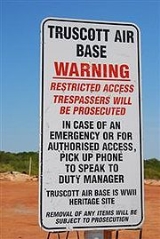
Mungalalu Truscott Airbase
Encyclopedia
Mungalalu Truscott Airbase, which during World War II was known as Truscott Airfield (or usually just simply referred to as Truscott) is today a commercial air field in the remote Kimberley region of Western Australia
. The airbase falls under the traditional ownership of the Wunambal Gaambera people (who use the traditional name for the area; Mungalalu). The base is managed by ShoreAir Pty Ltd and has been registered with the Civil Aviation Safety Authority as a commercial air base since April 2005. ShoreAir manages the Mungalalu Truscott Base under an agreement with the Wunambal Gaambera Aboriginal Corporation (WGAC). Agreement
has been reached with WGAC to sub lease the base area with licences for access to certain roads and areas of coastline for an initial term of twenty years expiring 30 June 2022 with right of renewal for a further twenty years.
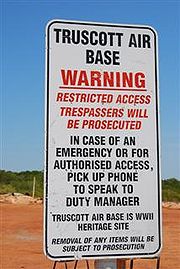 Mungalalu Truscott is some 281 nmi (520.4 km) west-southwest of Darwin
Mungalalu Truscott is some 281 nmi (520.4 km) west-southwest of Darwin
and 333 NM northeast of Broome
. Located on the Anjo Peninsula in the far North Kimberley district of Western Australia. Mungalalu Truscott occupies 46 km2 in an Aboriginal reserve.
 Mungalalu Truscott Base has been classified and entered into the Council of the National Trust of Australia (WA) list of Heritage Places due to its significance during World War II and the remaining artefacts. The Trust may nominate Mungalalu Truscott Base for inclusion by the Australian Heritage Commission in the Register of the National Estate in the future. The Trust has communicated that the classification has "no legal significance and does not infringe any rights of ownership" leaving administration to the joint understanding of the Operator (ShoreAir) and the WGAC.
Mungalalu Truscott Base has been classified and entered into the Council of the National Trust of Australia (WA) list of Heritage Places due to its significance during World War II and the remaining artefacts. The Trust may nominate Mungalalu Truscott Base for inclusion by the Australian Heritage Commission in the Register of the National Estate in the future. The Trust has communicated that the classification has "no legal significance and does not infringe any rights of ownership" leaving administration to the joint understanding of the Operator (ShoreAir) and the WGAC.
. Currently Super Puma helicopters operated by CHC Helicopters are based at Mungalalu Truscott and Bristow Helicopters are preparing to begin operations from the base in late 2007. Other regular users of the base include various pearl farm operators from the region and the Australian Customs Service
who use the airbase as a staging area for their aerial surveillance patrols in the area.
 Mungalalu Truscott is the largest all weather airbase in the Far North Kimberley Region. The sealed runway with PAPI lights for night operations is the premier option for companies with business interests in the region. Mungalalu Truscott complies with CASA MoS 139 regulation and allows unrestricted operations for aircraft up to 29 seat capacity. The runway is 1720 m in length and 30 m in width with turning nodes, ramps and taxiways, all areas have recently been sealed. Over the past 10 years the airfield has been regularly inspected by Connell Wagner and latest advice is that the pavement could trial aircraft with MAUW of 20 tonne
Mungalalu Truscott is the largest all weather airbase in the Far North Kimberley Region. The sealed runway with PAPI lights for night operations is the premier option for companies with business interests in the region. Mungalalu Truscott complies with CASA MoS 139 regulation and allows unrestricted operations for aircraft up to 29 seat capacity. The runway is 1720 m in length and 30 m in width with turning nodes, ramps and taxiways, all areas have recently been sealed. Over the past 10 years the airfield has been regularly inspected by Connell Wagner and latest advice is that the pavement could trial aircraft with MAUW of 20 tonne
s. In the past years, numerous aircraft types have utilised the Truscott aerodrome, they have included Fairchild Metro 23
, Embraer EMB 120 Brasilia
and Bombardier Dash 8. The Paspaley
pearling company subsidiary, Pearl Aviation
, stages its Grumman Mallard
flying boats from Truscott in support of its pearling operations in the region.
 As well as the regular aircraft operations from the base, the Wunambal Gaambera traditional owners operate a small tour company in the area around the base, guiding tourists around the heritage listed site, visiting several World War II relic sites along with some significant Aboriginal rock art sites found around the base. Expedition cruise vessels, such as the MV Orion
As well as the regular aircraft operations from the base, the Wunambal Gaambera traditional owners operate a small tour company in the area around the base, guiding tourists around the heritage listed site, visiting several World War II relic sites along with some significant Aboriginal rock art sites found around the base. Expedition cruise vessels, such as the MV Orion
operated by Orion Expedition Cruises
also visit the base.
.jpg) The airfield was originally constructed in 1944 as a Royal Australian Air Force
The airfield was originally constructed in 1944 as a Royal Australian Air Force
(RAAF) base and was actively used during World War II. RAAF Truscott was named after the Australian air ace, Keith "Bluey" Truscott
, who had been killed in an accident in 1943.
The World War II base was built to succeed a temporary base 80 km (50 mi) south at Drysdale River Mission (Kalumburu), and was a staging base for Allied
bomber
s and flying boat
s, from bases further south, making attacks on Japanese
targets in the Dutch East Indies
. The site was chosen because it is the point on the Australian mainland closest to Java, where Japanese forces were concentrated. Aircraft from nearby RAAF fighter squadrons (and occasionally RAF units) were rotated through the base to provide air defence for the base.
Construction and the subsequent operations from the base were conducted under total secrecy and the existence of the base was never formally acknowldged until after the war.
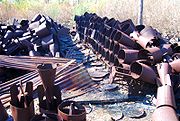 The host unit at the base was RAAF 58 Operating Base Unit (58OBU). Australian Army anti-aircraft and searchlight batteries were also based at Truscott scattered around the peninsula. A civilian work unit from the Allied Works Council was based at Truscott for the maintenance of roads around the base and a RAAF Marine Section was stationed in West Bay to support the Catalina Flying Boat operations, operate search and rescue water craft and support the maritime resupply of the air base.
The host unit at the base was RAAF 58 Operating Base Unit (58OBU). Australian Army anti-aircraft and searchlight batteries were also based at Truscott scattered around the peninsula. A civilian work unit from the Allied Works Council was based at Truscott for the maintenance of roads around the base and a RAAF Marine Section was stationed in West Bay to support the Catalina Flying Boat operations, operate search and rescue water craft and support the maritime resupply of the air base.
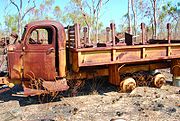 RAAF and USAAF heavy and medium bombers would stage through Truscott, often rearming and refuelling several times on bombing missions into Japanese held areas before returning to their home bases around Western Australia and the Northern Territory.
RAAF and USAAF heavy and medium bombers would stage through Truscott, often rearming and refuelling several times on bombing missions into Japanese held areas before returning to their home bases around Western Australia and the Northern Territory.
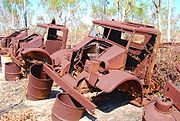 B-24 Liberator
B-24 Liberator
heavy bombers and B-25 Mitchell
medium bombers were two of the most common airframes to stage through Truscott. Catalina
flying boats operated from West Bay and Spitfire
aircraft were the most common fighter rotated through the base for local air defence.
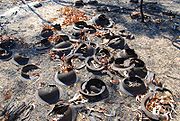 At the end of the war the base was closed down, with it playing a small role as a transit camp for the repatriation of Dutch citizens from the former Netherlands East Indies in 1946.
At the end of the war the base was closed down, with it playing a small role as a transit camp for the repatriation of Dutch citizens from the former Netherlands East Indies in 1946.
 Several significant air accidents occurred during the operation of the base in World War II.
Several significant air accidents occurred during the operation of the base in World War II.
On 16 November 1944, two Spitfires from 459 (RAF) Squadron collided while changing formation in preparation for landing at the base. Warrant Officer Bushell, pilot of Spitfire A58-364, managed to parachute to safety; but W/O Posse, pilot of A58-300 died in the crash. Remnants of both aircraft still exist near the present airstrip.
On 23 March 1945, Liberator A72-80, under the command of Squadron Leader N. H. Straus, crashed shortly after takeoff. Straus found that the plane was unable to climb above about 400 ft (130 m), and turned around at Parry Harbour. He was unable to see the runway, and the aircraft crashed into the sea about one kilometre short of Truscott, killing all on board (11 crew, and one passenger) .
On 20 May 1945, Liberator A72-160 (a B-24M-10-CO model), on a mission to Balikpapan
and piloted by Flt Lt F. L. Sismey, crashed soon after take off, near the north west end of the runway. The aircraft was destroyed by its depth charge
s exploding. All 11 crew members were killed.
 One of the most well known aircraft wrecks at Truscott actually pre-dates the base by two years. On the western side of the air base, in Vansittart Bay, there lies the wreckage of a USAAF Air Transport Command
One of the most well known aircraft wrecks at Truscott actually pre-dates the base by two years. On the western side of the air base, in Vansittart Bay, there lies the wreckage of a USAAF Air Transport Command
C-53 Skytrooper transport (a variant of the DC-3 Dakota; serial number 41-20066). This aircraft made an emergency landing on 26 February 1942, after the pilot got lost while flying from Perth to Broome, and put it down on a salt pan on Anjo Peninsula. The crew and passengers were rescued by a commercial flying boat several days later.
fishing boat.
Research done after the war has confirmed that Lieutenant Susuhiko Mizuno lead a special Japanese Army Reconnaissance party from Koepang, in Timor on board the Hiyoshi Maru. The party landed on Browse Island and stayed for about 3 hours. On the next morning they entered an inlet on the West Australian coast. Three landing parties led by Lieutenant Susuhiko Mizuno, Sergeant Morita and Sergeant Furuhashi, went ashore and explored different areas. They even took some 8 mm movie footage of what they saw. As it turned out they had landed only 25 km from where the RAAF were several weeks later to start building the secret airfield.
On 20 July 1944 a Japanese Mitsubishi Ki-46
-II "Dinah" Aircraft, piloted by Lt. Kiyoshi Izuka with his observer Lt. Hisao Itoh was shot down over the Anjo Peninsula by a flight of RAAF Spitfires killing both crew. As of September 2007 the remains of the Japanese aircraft was still on the peninsula near the current operating air base.
Western Australia
Western Australia is a state of Australia, occupying the entire western third of the Australian continent. It is bounded by the Indian Ocean to the north and west, the Great Australian Bight and Indian Ocean to the south, the Northern Territory to the north-east and South Australia to the south-east...
. The airbase falls under the traditional ownership of the Wunambal Gaambera people (who use the traditional name for the area; Mungalalu). The base is managed by ShoreAir Pty Ltd and has been registered with the Civil Aviation Safety Authority as a commercial air base since April 2005. ShoreAir manages the Mungalalu Truscott Base under an agreement with the Wunambal Gaambera Aboriginal Corporation (WGAC). Agreement
has been reached with WGAC to sub lease the base area with licences for access to certain roads and areas of coastline for an initial term of twenty years expiring 30 June 2022 with right of renewal for a further twenty years.
Location

Darwin, Northern Territory
Darwin is the capital city of the Northern Territory, Australia. Situated on the Timor Sea, Darwin has a population of 127,500, making it by far the largest and most populated city in the sparsely populated Northern Territory, but the least populous of all Australia's capital cities...
and 333 NM northeast of Broome
Broome, Western Australia
Broome is a pearling and tourist town in the Kimberley region of Western Australia, north of Perth. The year round population is approximately 14,436, growing to more than 45,000 per month during the tourist season...
. Located on the Anjo Peninsula in the far North Kimberley district of Western Australia. Mungalalu Truscott occupies 46 km2 in an Aboriginal reserve.
Heritage value

Current operations
Today the primary role of the airbase is that of a staging base for the workers in the nearby offshore oil and gas fields. Workers are flown into the base by fixed wing aircraft and then transferred to helicopters at Truscott for the final flight leg to the offshore platforms in and around the Timor SeaTimor Sea
The Timor Sea is a relatively shallow sea bounded to the north by the island of Timor, to the east by the Arafura Sea, to the south by Australia and to the west by the Indian Ocean....
. Currently Super Puma helicopters operated by CHC Helicopters are based at Mungalalu Truscott and Bristow Helicopters are preparing to begin operations from the base in late 2007. Other regular users of the base include various pearl farm operators from the region and the Australian Customs Service
Australian Customs Service
The Australian Customs and Border Protection Service is the Australian Federal Government agency responsible for managing the security and integrity of the Australian border, facilitating the movement of legitimate international travellers and goods, and collecting border-related duties and...
who use the airbase as a staging area for their aerial surveillance patrols in the area.

Tonne
The tonne, known as the metric ton in the US , often put pleonastically as "metric tonne" to avoid confusion with ton, is a metric system unit of mass equal to 1000 kilograms. The tonne is not an International System of Units unit, but is accepted for use with the SI...
s. In the past years, numerous aircraft types have utilised the Truscott aerodrome, they have included Fairchild Metro 23
Fairchild Swearingen Metroliner
The Fairchild Swearingen Metroliner or the Fairchild Aerospace Metro is a 19-seat, pressurised, twin turboprop airliner first produced by Swearingen Aircraft and later by Fairchild at a plant in San Antonio, Texas, United States....
, Embraer EMB 120 Brasilia
Embraer EMB 120 Brasilia
-Accidents:*Brazilian Air Force on July 8, 1988 an Embraer EMB 120RT Brasília registration FAB-2001 crashed during and engine-out landing at São José dos Campos. Five of the 9 occupants died....
and Bombardier Dash 8. The Paspaley
Paspaley
Paspaley is the largest pearling company in Australia. It started operations in the 1930s and is based in Darwin, Northern Territory, Australia. It has about 20 farms, situated between Dampier, Western Australia and the Cobourg Peninsula east of Darwin....
pearling company subsidiary, Pearl Aviation
Pearl Aviation
Pearl Aviation is the most prominent of a group of aviation companies owned by Paspaley Pearling. It is an air charter company based in Darwin, Northern Territory, Australia. It operates specialist aviation services including air ambulance, mining site flights, offshore oil support and contract...
, stages its Grumman Mallard
Grumman Mallard
|-See also:-References:NotesBibliography* Hotson, Fred W. Grumman Mallard: The Enduring Classic. Scarborough, Ontario: Robin Brass Studio, 2006. ISBN 978-1896941448....
flying boats from Truscott in support of its pearling operations in the region.

MV Orion
The MV Orion is currently based in Australia and operated by Orion Expedition Cruises . The ship has been described by the Berlitz Guide to Cruising as "the latest in the quest to build the perfect expedition vessel".-History:Built by Cassens shipyard in Germany for the Marshall Islands registered...
operated by Orion Expedition Cruises
Orion Expedition Cruises
Orion Expedition Cruises is an Australian-based luxury expedition cruise line that was formed in 2004. It currently operates a single vessel, the German-built 103 m, 4000 gross tonne MV Orion.- History :...
also visit the base.
World War II
.jpg)
Royal Australian Air Force
The Royal Australian Air Force is the air force branch of the Australian Defence Force. The RAAF was formed in March 1921. It continues the traditions of the Australian Flying Corps , which was formed on 22 October 1912. The RAAF has taken part in many of the 20th century's major conflicts...
(RAAF) base and was actively used during World War II. RAAF Truscott was named after the Australian air ace, Keith "Bluey" Truscott
Keith Truscott
Keith William "Bluey" Truscott DFC & Bar was a World War II ace fighter pilot and Australian rules footballer with the Melbourne Football Club...
, who had been killed in an accident in 1943.
The World War II base was built to succeed a temporary base 80 km (50 mi) south at Drysdale River Mission (Kalumburu), and was a staging base for Allied
Allies of World War II
The Allies of World War II were the countries that opposed the Axis powers during the Second World War . Former Axis states contributing to the Allied victory are not considered Allied states...
bomber
Bomber
A bomber is a military aircraft designed to attack ground and sea targets, by dropping bombs on them, or – in recent years – by launching cruise missiles at them.-Classifications of bombers:...
s and flying boat
Flying boat
A flying boat is a fixed-winged seaplane with a hull, allowing it to land on water. It differs from a float plane as it uses a purpose-designed fuselage which can float, granting the aircraft buoyancy. Flying boats may be stabilized by under-wing floats or by wing-like projections from the fuselage...
s, from bases further south, making attacks on Japanese
Empire of Japan
The Empire of Japan is the name of the state of Japan that existed from the Meiji Restoration on 3 January 1868 to the enactment of the post-World War II Constitution of...
targets in the Dutch East Indies
Dutch East Indies
The Dutch East Indies was a Dutch colony that became modern Indonesia following World War II. It was formed from the nationalised colonies of the Dutch East India Company, which came under the administration of the Netherlands government in 1800....
. The site was chosen because it is the point on the Australian mainland closest to Java, where Japanese forces were concentrated. Aircraft from nearby RAAF fighter squadrons (and occasionally RAF units) were rotated through the base to provide air defence for the base.
Construction and the subsequent operations from the base were conducted under total secrecy and the existence of the base was never formally acknowldged until after the war.



B-24 Liberator
The Consolidated B-24 Liberator was an American heavy bomber, designed by Consolidated Aircraft of San Diego, California. It was known within the company as the Model 32, and a small number of early models were sold under the name LB-30, for Land Bomber...
heavy bombers and B-25 Mitchell
B-25 Mitchell
The North American B-25 Mitchell was an American twin-engined medium bomber manufactured by North American Aviation. It was used by many Allied air forces, in every theater of World War II, as well as many other air forces after the war ended, and saw service across four decades.The B-25 was named...
medium bombers were two of the most common airframes to stage through Truscott. Catalina
PBY Catalina
The Consolidated PBY Catalina was an American flying boat of the 1930s and 1940s produced by Consolidated Aircraft. It was one of the most widely used multi-role aircraft of World War II. PBYs served with every branch of the United States Armed Forces and in the air forces and navies of many other...
flying boats operated from West Bay and Spitfire
Supermarine Spitfire
The Supermarine Spitfire is a British single-seat fighter aircraft that was used by the Royal Air Force and many other Allied countries throughout the Second World War. The Spitfire continued to be used as a front line fighter and in secondary roles into the 1950s...
aircraft were the most common fighter rotated through the base for local air defence.

World War II aircraft accidents

On 16 November 1944, two Spitfires from 459 (RAF) Squadron collided while changing formation in preparation for landing at the base. Warrant Officer Bushell, pilot of Spitfire A58-364, managed to parachute to safety; but W/O Posse, pilot of A58-300 died in the crash. Remnants of both aircraft still exist near the present airstrip.
On 23 March 1945, Liberator A72-80, under the command of Squadron Leader N. H. Straus, crashed shortly after takeoff. Straus found that the plane was unable to climb above about 400 ft (130 m), and turned around at Parry Harbour. He was unable to see the runway, and the aircraft crashed into the sea about one kilometre short of Truscott, killing all on board (11 crew, and one passenger) .
On 20 May 1945, Liberator A72-160 (a B-24M-10-CO model), on a mission to Balikpapan
Balikpapan
Balikpapan is a seaport city on the eastern coast of the island of Borneo, Indonesia, in the East Kalimantan province, a resource-rich region well known for its timber, mining, and petroleum export products. Two harbors, Semayang and Kariangau , and the Sepinggan International Airport are the main...
and piloted by Flt Lt F. L. Sismey, crashed soon after take off, near the north west end of the runway. The aircraft was destroyed by its depth charge
Depth charge
A depth charge is an anti-submarine warfare weapon intended to destroy or cripple a target submarine by the shock of exploding near it. Most use explosives and a fuze set to go off at a preselected depth in the ocean. Depth charges can be dropped by either surface ships, patrol aircraft, or from...
s exploding. All 11 crew members were killed.

Air Transport Command
Air Transport Command is an inactive United States Air Force unit. Its mission was to meet the urgent demand for the speedy reinforcement of the United States' military bases worldwide during World War II, using an air supply system to supplement surface transport...
C-53 Skytrooper transport (a variant of the DC-3 Dakota; serial number 41-20066). This aircraft made an emergency landing on 26 February 1942, after the pilot got lost while flying from Perth to Broome, and put it down on a salt pan on Anjo Peninsula. The crew and passengers were rescued by a commercial flying boat several days later.
Japanese activity
On 18 January, 1944, Sergeants Castle and Martin, part of an RAAF unit making preparations for construction of the airfield heard a vessel which they suspected was a Japanese submarine or boat. In order to prevent Japanese forces learning of Truscott's location, they did not investigate. They reported their story to North-Western Area Headquarters who thought that it may have been a Japanese submarine running on the surface to charge its batteries. It was later confirmed that they had heard a Japanese reconnaissance vessel named Hiyoshi Maru, a converted 25 tonTon
The ton is a unit of measure. It has a long history and has acquired a number of meanings and uses over the years. It is used principally as a unit of weight, and as a unit of volume. It can also be used as a measure of energy, for truck classification, or as a colloquial term.It is derived from...
fishing boat.
Research done after the war has confirmed that Lieutenant Susuhiko Mizuno lead a special Japanese Army Reconnaissance party from Koepang, in Timor on board the Hiyoshi Maru. The party landed on Browse Island and stayed for about 3 hours. On the next morning they entered an inlet on the West Australian coast. Three landing parties led by Lieutenant Susuhiko Mizuno, Sergeant Morita and Sergeant Furuhashi, went ashore and explored different areas. They even took some 8 mm movie footage of what they saw. As it turned out they had landed only 25 km from where the RAAF were several weeks later to start building the secret airfield.
On 20 July 1944 a Japanese Mitsubishi Ki-46
Mitsubishi Ki-46
The Mitsubishi Ki-46 was a twin-engine reconnaissance aircraft used by the Imperial Japanese Army in World War II. Its Army Shiki designation was Type 100 Command Reconnaissance Aircraft ; the Allied nickname was "Dinah"....
-II "Dinah" Aircraft, piloted by Lt. Kiyoshi Izuka with his observer Lt. Hisao Itoh was shot down over the Anjo Peninsula by a flight of RAAF Spitfires killing both crew. As of September 2007 the remains of the Japanese aircraft was still on the peninsula near the current operating air base.
External links
- Peter Dunn, 2000, ozatwar.com, "Truscott Airfield on Anjo Peninsular in Western Australia during WW2" (includes maps)
- More from ozatwar.com
- Attorney-General's Department, 2004, "Truscott Airbase extension strengthens remote coastal surveillance"
- pacificwrecks.com "Truscott" (includes pictures)
- Kimberley Land Council announcement on the leasing of Truscott Air Base
- Shoreair Current Managers of Truscott
- More from ShoreAir on Truscott
- Pacific Wrecks site on the "Dinah" Japanese wreck at Truscott
- Information about A72-80 crash
- Page at "Aussie Heritage" website

